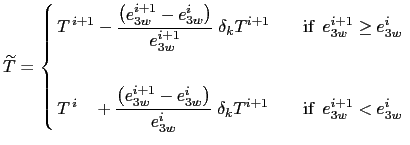Next: Ocean Dynamics (DYN) Up: Ocean Tracers (TRA) Previous: Equation of State (eosbn2) Contents Index
With partial cells (ln_zps=true) at bottom and top (ln_isfcav=true), in general, tracers in horizontally adjacent cells live at different depths. Horizontal gradients of tracers are needed for horizontal diffusion (traldf.F90 module) and for the hydrostatic pressure gradient (dynhpg.F90 module) to be active.
Before taking horizontal gradients between the tracers next to the bottom, a linear
interpolation in the vertical is used to approximate the deeper tracer as if it actually
lived at the depth of the shallower tracer point (Fig. 5.5).
For example, for temperature in the ![]() -direction the needed interpolated
temperature,
-direction the needed interpolated
temperature,
![]() , is:
, is:
 |
The computation of horizontal derivative of tracers as well as of density is
performed once for all at each time step in zpshde.F90 module and stored
in shared arrays to be used when needed. It has to be emphasized that the
procedure used to compute the interpolated density,
![]() , is not
the same as that used for
, is not
the same as that used for ![]() and
and ![]() . Instead of forming a linear approximation
of density, we compute
. Instead of forming a linear approximation
of density, we compute
![]() from the interpolated values of
from the interpolated values of ![]() and
and ![]() , and the pressure at a
, and the pressure at a ![]() -point (in the equation of state pressure is
approximated by depth, see §5.8.1 ) :
-point (in the equation of state pressure is
approximated by depth, see §5.8.1 ) :
This is a much better approximation as the variation of ![]() with depth (and
thus pressure) is highly non-linear with a true equation of state and thus is badly
approximated with a linear interpolation. This approximation is used to compute
both the horizontal pressure gradient (§6.4) and the slopes of neutral
surfaces (§9.2)
with depth (and
thus pressure) is highly non-linear with a true equation of state and thus is badly
approximated with a linear interpolation. This approximation is used to compute
both the horizontal pressure gradient (§6.4) and the slopes of neutral
surfaces (§9.2)
Note that in almost all the advection schemes presented in this Chapter, both
averaging and differencing operators appear. Yet (5.28) has not
been used in these schemes: in contrast to diffusion and pressure gradient
computations, no correction for partial steps is applied for advection. The main
motivation is to preserve the domain averaged mean variance of the advected
field when using the ![]() order centred scheme. Sensitivity of the advection
schemes to the way horizontal averages are performed in the vicinity of partial
cells should be further investigated in the near future.
order centred scheme. Sensitivity of the advection
schemes to the way horizontal averages are performed in the vicinity of partial
cells should be further investigated in the near future.
If under ice shelf seas opened (ln_isfcav=true), the partial cell properties
at the top are computed in the same way as for the bottom. Some extra variables are,
however, computed to reduce the flow generated at the top and bottom if ![]() coordinates activated.
The extra variables calculated and used by §6.4.4 are:
coordinates activated.
The extra variables calculated and used by §6.4.4 are:
![]()
![]() as described in (5.28)
as described in (5.28)
![]()
![]() to compute
the pressure gradient correction term used by (6.20) in §6.4.4,
with
to compute
the pressure gradient correction term used by (6.20) in §6.4.4,
with
![]() the depth of the point
the depth of the point
![]() in case of
in case of ![]() coordinates
(this term = 0 in z-coordinates)
coordinates
(this term = 0 in z-coordinates)
Gurvan Madec and the NEMO Team
NEMO European Consortium2017-02-17